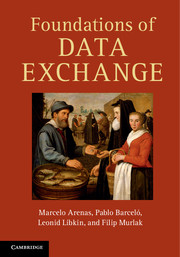Book contents
- Frontmatter
- Dedication
- Contents
- Preface
- Part One GETTING STARTED
- Part Two RELATIONAL DATA EXCHANGE
- 4 The problem of relational data exchange
- 5 Existence of solutions
- 6 Good solutions
- 7 Query answering and rewriting
- 8 Alternative semantics
- 9 Endnotes to Part Two
- Part Three XML DATA EXCHANGE
- Part Four METADATA MANAGEMENT
- References
- Index
8 - Alternative semantics
from Part Two - RELATIONAL DATA EXCHANGE
Published online by Cambridge University Press: 05 June 2014
- Frontmatter
- Dedication
- Contents
- Preface
- Part One GETTING STARTED
- Part Two RELATIONAL DATA EXCHANGE
- 4 The problem of relational data exchange
- 5 Existence of solutions
- 6 Good solutions
- 7 Query answering and rewriting
- 8 Alternative semantics
- 9 Endnotes to Part Two
- Part Three XML DATA EXCHANGE
- Part Four METADATA MANAGEMENT
- References
- Index
Summary
So far, our default semantics for answering queries in data exchange was the certain answers semantics. But is it always right to use it? After all, we have seen that even in the simplest possible, copying mappings, that essentially say “copy the source to the target”, some relational algebra queries cannot be answered (see Proposition 7.16 in Section 7.6). This is rather counter-intuitive behavior: one should expect that, in a copying mapping, relations simply change name but not content, and queries should be answerable over a copy of the source.
The standard certain answers semantics presents us with a host of problems:
• some queries are not rewritable even under the simplest mappings;
• computing answers to relational algebra queries is in general an undecidable problem; and
• computing certain answers could be intractable even for very simple and practically relevant classes of queries (e.g., conjunctive queries with inequalities, or SQL queries admitting inequalities in the where clause, as shown in Theorem 7.4).
Should we always follow the certain answers semantics? Is it really sacred in data exchange? Or perhaps we can find an alternative data exchange semantics that avoids the problems we listed above?
In a way, there is no fully satisfactory answer to these questions. Every semantics one presents is going to work well in some scenarios, and exhibit problems in others, and thus the choice of the semantics depends on the precise interpretation of what the mapping rules actually mean. But alternative semantics have been proposed, and we present several here that attempt to solve the problems above.
- Type
- Chapter
- Information
- Foundations of Data Exchange , pp. 97 - 123Publisher: Cambridge University PressPrint publication year: 2014



